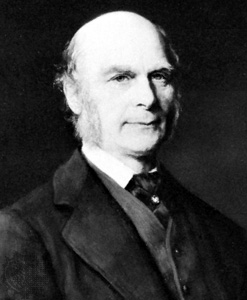Nature versus nurture is a long-standing debate in biology and society about the relative influence on human beings of their genetic inheritance (nature) and the environmental conditions of their development (nurture). The alliterative expression "nature and nurture" in English has been in use since at least the Elizabethan period and goes back to medieval French. The complementary combination of the two concepts is an ancient concept. Nature is what people think of as pre-wiring and is influenced by genetic inheritance and other biological factors. Nurture is generally taken as the influence of external factors after conception e.g. the product of exposure, experience and learning on an individual.

The relationship between biology and sexual orientation is a subject of on-going research. While scientists do not know the exact cause of sexual orientation, they theorize that it is caused by a complex interplay of genetic, hormonal, and environmental influences. However, evidence is weak for hypotheses that the post-natal social environment impacts sexual orientation, especially for males.

Twins are two offspring produced by the same pregnancy. Twins can be either monozygotic ('identical'), meaning that they develop from one zygote, which splits and forms two embryos, or dizygotic, meaning that each twin develops from a separate egg and each egg is fertilized by its own sperm cell. Since identical twins develop from one zygote, they will share the same sex, while fraternal twins may or may not. In very rare cases fraternal twins can have the same mother and different fathers.
Twin studies are studies conducted on identical or fraternal twins. They aim to reveal the importance of environmental and genetic influences for traits, phenotypes, and disorders. Twin research is considered a key tool in behavioral genetics and in related fields, from biology to psychology. Twin studies are part of the broader methodology used in behavior genetics, which uses all data that are genetically informative – siblings studies, adoption studies, pedigree, etc. These studies have been used to track traits ranging from personal behavior to the presentation of severe mental illnesses such as schizophrenia.

A sibling is a relative that shares at least one parent with the other person. A male sibling is a brother, and a female sibling is a sister. A person with no siblings is an only child.

Human behaviour genetics is an interdisciplinary subfield of behaviour genetics that studies the role of genetic and environmental influences on human behaviour. Classically, human behavioural geneticists have studied the inheritance of behavioural traits. The field was originally focused on determining the importance of genetic influences on human behaviour. It has evolved to address more complex questions such as: how important are genetic and/or environmental influences on various human behavioural traits; to what extent do the same genetic and/or environmental influences impact the overlap between human behavioural traits; how do genetic and/or environmental influences on behaviour change across development; and what environmental factors moderate the importance of genetic effects on human behaviour. The field is interdisciplinary, and draws from genetics, psychology, and statistics. Most recently, the field has moved into the area of statistical genetics, with many behavioural geneticists also involved in efforts to identify the specific genes involved in human behaviour, and to understand how the effects associated with these genes changes across time, and in conjunction with the environment.
Thomas J. Bouchard Jr. is an American psychologist known for his behavioral genetics studies of twins raised apart. He is professor emeritus of psychology and director of the Minnesota Center for Twin and Adoption Research at the University of Minnesota. Bouchard received his PhD from the University of California, Berkeley, in 1966.
The Minnesota Center for Twin and Family Research (MCTFR) is a series of behavioral genetic longitudinal studies of families with twin or adoptive offspring conducted by researchers at the University of Minnesota. It seeks to identify and characterize the genetic and environmental influences on the development of psychological traits.

David Thoreson Lykken was a behavioral geneticist and Professor Emeritus of Psychology and Psychiatry at the University of Minnesota. He is best known for his work on twin studies and lie detection.

Twins Days is held annually on the first full weekend in August in Twinsburg, Ohio, United States to celebrate biological twins. The event has taken place every summer since 1976 when the festival was founded by a group of Twinsburg citizens, based on a concept developed by Ray Diersing, Sage Hiller, and Ari Hiller. The first time Twins Day was proposed to city council, it was rejected; city council thought it was a bad idea. It is the largest annual gathering of twins in the world, and draws thousands of participants from all over the United States and elsewhere in the world.
In psychology, a trait is called emergenic if it is the result of a specific combination of several interacting genes. Emergenic traits will not run in families, but identical twins will share them. Traits such as "leadership", "genius" or certain mental illnesses may be emergenic. Although one may expect epigenetics to play a significant role in the phenotypic manifestation of twins reared apart, the concordance displayed between them can be attributed to emergenesis.
In genetics, concordance is the probability that a pair of individuals will both have a certain characteristic given that one of the pair has the characteristic. Concordance can be measured with concordance rates, reflecting the odds of one person having the trait if the other does. Important clinical examples include the chance of offspring having a certain disease if the mother has it, if the father has it, or if both parents have it. Concordance among siblings is similarly of interest: what are the odds of a subsequent offspring having the disease if an older child does? In research, concordance is often discussed in the context of both members of a pair of twins. Twins are concordant when both have or both lack a given trait. The ideal example of concordance is that of identical twins, because the genome is the same, an equivalence that helps in discovering causation via deconfounding, regarding genetic effects versus epigenetic and environmental effects.

Autism has multiple causes. This article focuses on heritable causes. The heritability of autism is the proportion of differences in expression of autism that can be explained by genetic variation; if the heritability of a condition is high, then the condition is considered to be primarily genetic. Autism has a strong genetic basis. Although the genetics of autism are complex, autism spectrum disorder (ASD) is explained more by multigene effects than by rare mutations with large effects.

Irving Isadore Gottesman was an American professor of psychology who devoted most of his career to the study of the genetics of schizophrenia. He wrote 17 books and more than 290 other publications, mostly on schizophrenia and behavioral genetics, and created the first academic program on behavioral genetics in the United States. He won awards such as the Hofheimer Prize for Research, the highest award from the American Psychiatric Association for psychiatric research. Lastly, Gottesman was a professor in the psychology department at the University of Minnesota, where he received his Ph.D.
Hermann Werner Siemens was a German dermatologist who first described multiple skin diseases and was one of the inventors of the twin study. Siemens' work in twin studies is influential in modern genetics and is used to address the environmental and genetic impacts upon traits. Siemens was involved in racial hygiene and affiliated with the Nazi Party.
Behavioural genetics, also referred to as behaviour genetics, is a field of scientific research that uses genetic methods to investigate the nature and origins of individual differences in behaviour. While the name "behavioural genetics" connotes a focus on genetic influences, the field broadly investigates the extent to which genetic and environmental factors influence individual differences, and the development of research designs that can remove the confounding of genes and environment. Behavioural genetics was founded as a scientific discipline by Francis Galton in the late 19th century, only to be discredited through association with eugenics movements before and during World War II. In the latter half of the 20th century, the field saw renewed prominence with research on inheritance of behaviour and mental illness in humans, as well as research on genetically informative model organisms through selective breeding and crosses. In the late 20th and early 21st centuries, technological advances in molecular genetics made it possible to measure and modify the genome directly. This led to major advances in model organism research and in human studies, leading to new scientific discoveries.
Brian J. Byrne is an Australian social scientist specializing in applied and psycholinguistics, an emeritus professor at the University of New England in Australia, and lead author of publications and articles on research in his field. Byrne was a lead researcher in the 10-year-long, $5 million National Institutes of Health study by an international team of scientists into the development of reading ability in 1,000 pairs of twins. Beginning in 2000, the study found that genetics were more important influences on reading development than environmental factors. In 2012, Byrne was appointed a lead researcher in a similar Australian study of twins.

TwinsUK, also known as TwinsUK Registry, is the biggest UK adult registry of twins in the United Kingdom, ages 16 to 98 to study the genetic and environmental aetiology of age related complex traits and diseases. Established in 1993, it is based at King's College London with an intent of aiding genetic research. The registry is used to connect researchers to volunteers.
Genome-wide complex trait analysis (GCTA) Genome-based restricted maximum likelihood (GREML) is a statistical method for heritability estimation in genetics, which quantifies the total additive contribution of a set of genetic variants to a trait. GCTA is typically applied to common single nucleotide polymorphisms (SNPs) on a genotyping array and thus termed "chip" or "SNP" heritability.